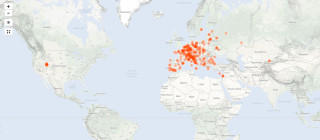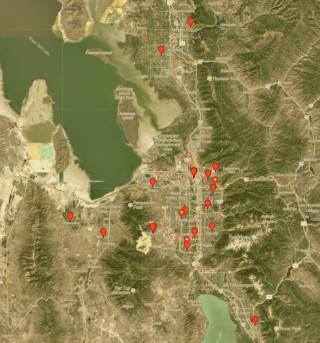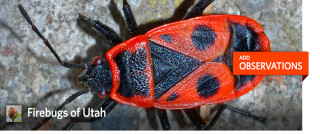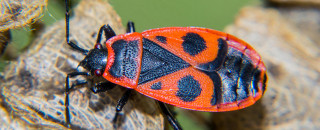European Firebug Spreads in Utah
By Lisa Thompson
Among the many things that make Utah unusual is our population of European firebugs (Pyrrocohoris apterus). Northern Utah is the only place in the entire western hemisphere you can find these bugs. Natives of Europe, firebugs were first documented in Salt Lake County in 2008. How they got here is a mystery. Perhaps they stowed away on some imported plant material. Now that this new species has settled in Utah, we need your help to track how they are dispersing in their new home.

For the last two years, the Natural History Museum of Utah has asked citizen scientists–like you–to report their firebug sightings. “We have a unique opportunity to track the spread of an insect that is new to our area,” explains NHMU Entomology Collection Manager Christy Bills. “With the help of observers throughout the state, we can monitor the expansion of its range, providing vital information to international reserachers.”

In 2017, citizen scientists documented significant expansion in our firebug population’s range. To the north, we had our first report of firebugs in Ogden and, in the south, the first sighting in Provo. Firebugs are moving east and west, too. Citizen scientists spotted them for the first time this year on the east side of the Wasatch Mountains at Soldier Summit and to the west in Tooele, Grantsville, and Cedar Fort.
The firebug population also appears to be getting larger. Citizen scientists submitted many more observations of them in 2017 than 2016. Check out all the observations contributed to date in the Firebugs of Utah project.
You can join the effort to document how the firebug populations spreads and grows in Utah. The project utilizes the free iNaturalist app. Once you download iNaturalist to your mobile device, watch a short tutorial on iNaturalist and learn how to make great observations. Then take pictures of firebugs wherever you see them and add them to the Firebugs of Utah project.

Identifying firebugs is easy. Firebugs look similar to box elder bugs (Boisea trivittata), but firebugs have a red body with two black dots on their back. They also have prominent eyes that seem to come from their shoulders. And, unlike box elder bugs, firebugs can’t fly.
Firebugs are harmless to humans. They only eat seeds, so they won’t damage your garden. It also seems unlikely that they will be disruptive to our local ecosystems. They have many predators in Europe, including birds, mammals, ants, and mites, and are probably being gobbled up here, too. The data gathered by citizen scientists will ultimately help scientists better understand the ecological role of firebugs in Utah.
First image of European Firebug on flower, credit Shutterstock.
Lisa Thompson is an exhibit developer at the Natural History Museum of Utah, a part of the University of Utah in Salt Lake City. Our mission is to illuminate the natural world and the place of humans within it. In addition to housing outstanding exhibits for the public, NHMU is a research museum. Learn more.
